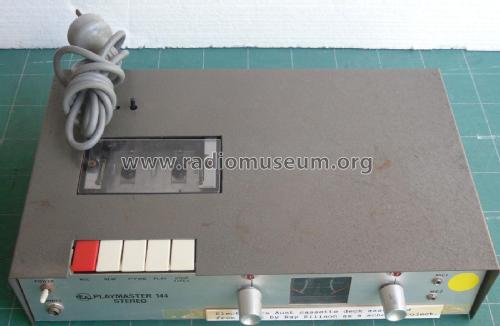Playmaster Stereo Cassette Deck 144
Radio and Hobbies, Radio Television & Hobbies, Electronics Australia magazine; Sydney
- País
- Australia
- Fabricante / Marca
- Radio and Hobbies, Radio Television & Hobbies, Electronics Australia magazine; Sydney
- Año
- 1974
- Categoría
- Registrador o reproductor de sonido o visual
- Radiomuseum.org ID
- 338237
- Numero de transistores
- Hay semiconductores.
- Semiconductores
- Principio principal
- Amplificador de Audio
- Gama de ondas
- - no hay
- Especialidades
- Grabador y/o Reprod de cassetes
- Tensión de funcionamiento
- Red: Corriente alterna (CA, Inglés = AC) / 240 Volt
- Material
- Metálico
- de Radiomuseum.org
- Modelo: Playmaster Stereo Cassette Deck 144 - Radio and Hobbies, Radio
- Forma
- Sobremesa de botonera.
- Ancho, altura, profundidad
- 360 x 80 x 240 mm / 14.2 x 3.1 x 9.4 inch
- Anotaciones
-
The stereo deck is designed around the Vortex cassette mechanism and with all the recording and replay circuitry necessary to enable it to be connected to a stereo amplifier via the line inputs. It has quite a number of what we feel are interesting features, particularly as some are not available on commercial machines.
Dual-level meters are provided for signal monitoring during recording. These are backed up with two LED indicators that flash instant warnings of transient overload. Thus, peak signals which cannot be “followed” by the meters are detected and indicated.
Normally, the level meters do not operate on playback. However, they can be made to indicate the relative level of the playback signal if the deck output is connected to the amplifier Auxiliary inputs rather than the Tape Monitor inputs, with the deck input still connected to the Tape output of the amplifier. In this way, the recording amplifiers may be fed with the playback signal. No instability problems result from this mode of operation.
The level controls are of the rotary type rather than the now popular sliding type.
Independent recording level controls are provided. These affect only the signals from the microphone or line inputs on the recording.
They do not affect playback levels. This is as it should be.
All playback level control is performed by the amplifier to which the unit is connected.A stereo headphone socket is provided for listening to the playback of tapes without having to connect an amplifier. Normal 8 Ω or high impedance phones may be used. No level control is provided for this output, but the level can be easily varied if need be by selecting one resistor in each channel.
3.5 mm jack sockets are provided for two low impedance microphones (250 to 600 Ω). These are shorting jacks so that noise from the recording preamplifier is minimised when the microphones are not in use. A five-pin DIN socket provides line inputs and outputs at a level of about 100 mV, to suit typical stereo amplifiers.
Other sources, such as AM tuner, tape recorder, or ceramic cartridge in a record player may also be used for recording. The input impedance for the line inputs is 330k so bass response will be limited when used with ceramic cartridges.
Complete instruction & schematic were published in the Electronics Australia, August 1974 edition.
- Peso neto
- 4 kg / 8 lb 13 oz (8.811 lb)
- Precio durante el primer año
- 97.00 AUS $
- Mencionado en
- -- Original prospect or advert ( Electronics Australia, August 1974, Page 54.)
- Autor
- Modelo creado por Keith Ellison. Ver en "Modificar Ficha" los participantes posteriores.
- Otros modelos
-
Donde encontrará 35 modelos, 19 con imágenes y 29 con esquemas.
Ir al listado general de Radio and Hobbies, Radio Television & Hobbies, Electronics Australia magazine; Sydney
Colecciones
El modelo Playmaster Stereo Cassette Deck es parte de las colecciones de los siguientes miembros.
